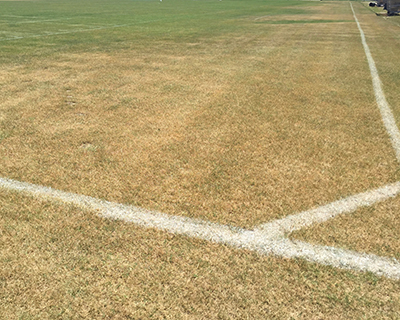Helping your turf during dry and hot weather
Throughout much of Michigan, lawns are under stress from high temperatures and lack of rainfall.

The lack of significant rainfall across many areas of Michigan combined with high temperatures has resulted in turfgrass stress. Lawns that were soaking wet throughout much of April and early May have now turned brown. Many homeowners choose not to irrigate their lawn and, once the lawn starts to turn brown and rainfall doesn’t return, the concern and questions arise as to whether or not the lawn might die.
The vast majority of lawns in Michigan are primarily composed of Kentucky bluegrass. Typically, there is no danger that the lawn is going to die unless water is lacking for six to eight weeks in combination with high temperatures. However, there are no solid day estimates without water for predicting whether the turf will die as many other factors are involved such as high temperatures and traffic.
Even if you don’t regularly water your lawn, it might be a good idea to give the turf a little water if it hasn’t received any water for a month. Apply about 0.5 to 1 inch of water just to make sure the lawn makes it through this dry period. The goal of this irrigation is not to turn it green but just to prevent the turf from completely desiccating (severe drying out) and possibly dying. If the weather pattern remains dry I would continue to irrigate at least once every three to four weeks at a minimum.
Helpful tips for managing turf during hot and dry weather

Don’t worry about trying to control weeds right now in drought stressed turf. Just like the turf, many of these weeds are slowing down their growth and trying to control them now would be more difficult, besides they might be the only green color in the turf.
Heat tracks are becoming common on both home lawns and golf courses. Anytime you put traffic from a cart, mower or spreader on turf that is nearing the wilting point or has already wilted, you will likely see a track in the following days or week. For those who have irrigated and still have some green turf, avoid mowing during the heat of the afternoon. Mow during the cooler times of the day, early morning or in the evening after dinner.
Also, maintain the highest mowing height possible. Don’t think that by mowing lower you’ll help the turf by reducing the amount of leaf area the roots have to support. Remember if the turf doesn’t have any leaves it can’t harvest light for photosynthesis and the result is that more energy will be spent to produce new leaf tissue. Mow high and mow in the coolest part of the day.
If you have an irrigation system, make sure to watch the heads to make sure everything is firing on all cylinders. When conditions get dry, gaps in coverage become obvious and green and brown circles indicative of poor irrigation coverage become obvious.
Soil differences across an area can result in visual differences in turfgrass very similar to those seen with poorly functioning irrigation systems. Although we hope or think we have a very uniform soil type to grow our turf, in reality soil properties can vary drastically, even across a home lawn.



 Print
Print Email
Email
